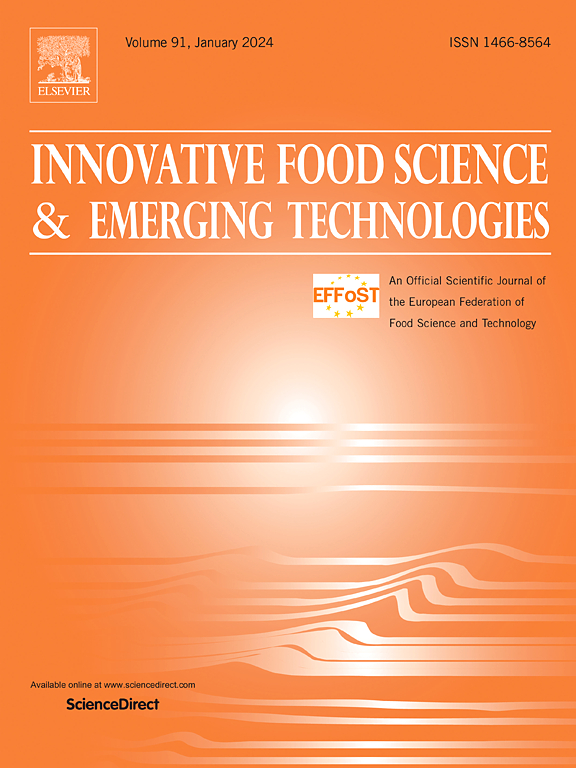Rheological property modification and microbial inactivation of hawthorn jam under ultra-high-voltage electrostatic field
IF 6.8
1区 农林科学
Q1 FOOD SCIENCE & TECHNOLOGY
Innovative Food Science & Emerging Technologies
Pub Date : 2025-06-23
DOI:10.1016/j.ifset.2025.104095
引用次数: 0
Abstract
Ultra-high-voltage electrostatic field sterilisation (UVEFS) is an emerging technology for the non-thermal modification and microbial inactivation of soft food materials. However, the effect of UVEFS on soft food materials remains unclear. In this study, hawthorn jam, a type of soft food material, was subjected to continuous UVEFS at 60 kV and a flow rate of 5 g/min to assess its rheological properties, microbial inactivation, and quality attributes in comparison with those of hawthorn jam treated with water bath, microwave, radio frequency. The UVEFS-treated hawthorn jam displayed higher viscoelasticity (G' = 1902 Pa, G" = 718 Pa), rheological properties (K = 310 Pa·sn), gel strength (20.84 g*cm), and water-binding capacity than the jams treated using other methods. Furthermore, the UVEFS group demonstrated a microbial lethality rate of over 90 %, with the population of moulds and yeasts were reduced by 1.78 log CFU/mL, and its nutrient contents were better maintained. Unlike the jams subjected to other thermal treatments, which showed a decrease in total phenolic content (TPC), hawthorn jam treated by UVEFS demonstrated a 2 % increase in TPC. The pectin content of the UVEFS-treated jam was basically identical to that of the non-treated sample, and improvements in flavor and colour were observed (ΔE = 1.32). Overall, the rheological and quality properties of the hawthorn jam prepared by UVEFS were significantly better than those of hawthorn jam prepared by other thermal treatment methods. Therefore, as a new non-thermal processing technology for soft food materials, UVEFS has potential application value in the processing and storage of uniform and viscous soft food materials such as fruit and vegetable jams and pastes.
Industrial relevance
Soft foods are thermally treated to achieve sterilisation. However, this process can affect the gel properties and quality of food. In this study, we developed a novel non-thermal sterilisation technology using ultra-high-pressure electrostatic fields. Food treated using this technology showed improvements in gel properties and better quality than food subjected to thermal treatment. Therefore, as a new non-thermal processing technology for soft food materials, UVEFS has potential application value in the processing and storage of uniform and viscous soft food materials such as fruit and vegetable jams and pastes.
超高压静电场下山楂果酱流变特性改性及微生物失活研究
超高压静电场灭菌(UVEFS)是一种新兴的软质食品材料的非热改性和微生物灭活技术。然而,UVEFS对软质食品材料的影响尚不清楚。本研究以软质食品原料山楂果酱为研究对象,在60 kV、5 g/min的连续UVEFS下,与水浴、微波、射频处理的山楂果酱进行比较,考察其流变学特性、微生物失活特性和品质特性。uvefs处理后的山楂果酱具有较高的粘弹性(G′= 1902 Pa, G′= 718 Pa)、流变性能(K = 310 Pa·sn)、凝胶强度(20.84 G *cm)和结水能力。UVEFS组微生物致死率达90%以上,霉菌和酵母菌数量减少1.78 log CFU/mL,营养物质含量得到较好的维持。与其他热处理处理的果酱总酚含量(TPC)下降不同,UVEFS处理的山楂果酱总酚含量增加了2%。经uvefs处理的果酱果胶含量与未处理的果酱基本相同,风味和颜色也有所改善(ΔE = 1.32)。综上所述,UVEFS法制备的山楂果酱的流变性能和品质性能均明显优于其他热处理法制备的山楂果酱。因此,UVEFS作为一种新型的软性食品材料非热加工技术,在果蔬果酱、糊状等均匀粘性软性食品材料的加工和储存方面具有潜在的应用价值。工业相关性软食品经过热处理以达到灭菌。然而,这个过程会影响食品的凝胶特性和质量。在这项研究中,我们开发了一种利用超高压静电场的新型非热灭菌技术。用这种技术处理的食品比经过热处理的食品表现出凝胶性能的改善和质量的提高。因此,UVEFS作为一种新型的软性食品材料非热加工技术,在果蔬果酱、糊状等均匀粘性软性食品材料的加工和储存方面具有潜在的应用价值。
本文章由计算机程序翻译,如有差异,请以英文原文为准。
求助全文
约1分钟内获得全文
求助全文
来源期刊
CiteScore
12.00
自引率
6.10%
发文量
259
审稿时长
25 days
期刊介绍:
Innovative Food Science and Emerging Technologies (IFSET) aims to provide the highest quality original contributions and few, mainly upon invitation, reviews on and highly innovative developments in food science and emerging food process technologies. The significance of the results either for the science community or for industrial R&D groups must be specified. Papers submitted must be of highest scientific quality and only those advancing current scientific knowledge and understanding or with technical relevance will be considered.

 求助内容:
求助内容: 应助结果提醒方式:
应助结果提醒方式:


